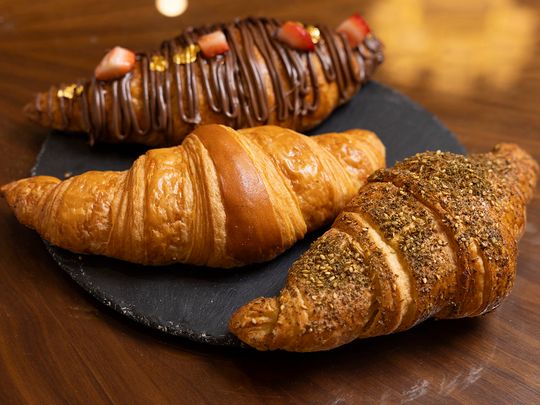Ingredients
750 gms T-45 or 00 all-purpose flour
250 gms T-55 or 0 Italian flour
31 gms yeast
20 gms salt
10 gms bread improver (optional)
62 gms milk powder
125 gms sugar
62 gms whole egg
44 gms butter
440 ml water
For laminating dough
300 gms butter
For egg wash
3 eggs
50 ml milk
Method
Using a mixer, combine all the ingredients to make the dough. Run the mixer for 3 minutes at a slow speed, followed by 7 minutes at a fast speed.
Scale the dough to 1 kg and let it rest in the freezer for about 4 hours.
Remove the dough from the freezer and defrost it until it is ready to roll.
Roll out 300 grams of butter to a thickness of 8 mm and fold it inside the dough.
For the first fold, fold the dough either once or overlap it. Rest the dough in the freezer for 15 minutes.
For the second fold, make a double fold or book fold. (To learn how to book fold, refer to the video.)
Wrap the dough and freeze it overnight.
Triangles:
Roll out the dough and cut it into triangular shapes of the desired size. Aim for a rectangle roughly 12 inches (30 cm) wide and 4 inches (10 cm) high. Use a rolling pin on a lightly floured surface.
Cut into triangles
Long triangles: Cut the dough in half lengthwise, then cut each half diagonally into 6 triangles. This will yield 12 small croissants.
Smaller triangles: Cut the dough into thirds lengthwise, then cut each third diagonally into 4 triangles. This will yield 24 even smaller croissants.
Roll up each triangle starting from the base, stretching it gently as you roll to create a crescent shape.
Make each triangle into a croissant shape and put them in the freezer for about 2 hours.
Proof the croissants until they are ready to bake. Brush each individual piece with egg wash and bake in a rotating oven at 170°C for about 12 minutes. Let the croissants cool on a wire rack before serving. Try different fillings like zaatar, cheese and chocolate for various flavours.
Laminating dough:
The process of laminating dough involves folding butter into dough several times, creating alternating layers of butter and dough.
Tips:
Use high-quality flours with good gluten content for optimal elasticity and layering.
Ensure the butter is cold but pliable when incorporating it into the dough.
Don't over-proof the croissants, as they can become dense and lose their flakiness.
Adjust the baking time as needed based on your oven and the desired level of browning.
Proofing the dough is a crucial step in bread baking, particularly for yeast-based breads like croissants, baguettes, and pizza dough. It's the period when the yeast feeds on sugars in the dough, producing carbon dioxide gas. This gas gets trapped by the gluten network, causing the dough to rise and become light and airy.
Here's a breakdown of what happens during proofing:
1. Activation: During proofing, the yeast cells rehydrate and become active. They start to consume the sugars in the dough, converting them into carbon dioxide and other elements.
2. Fermentation: As the yeast works, it produces more and more carbon dioxide gas. This gas gets trapped by the gluten network, which stretches and expands to accommodate the increasing volume.
3. Flavour development: The fermentation process also creates byproducts that contribute to the flavor and aroma of the bread.
There are two main types of proofing:
Bulk fermentation: This is the first rise of the dough after all the ingredients are mixed. It usually happens at room temperature and can take anywhere from 30 minutes to several hours, depending on the recipe and the type of yeast used.
Final proofing: This is the second rise of the dough after it has been shaped into its final form (e.g., loaves, rolls, croissants). It usually happens in a warm, humid environment (like a proofing box) and can take anywhere from 30 minutes to an hour.
Here are some additional things to know about proofing the dough:
Proofing time can vary: The length of time needed for proofing depends on several factors, such as the recipe, the temperature, the type of yeast used, and the amount of sugar in the dough. It's important to follow the recipe and watch for signs that the dough is ready, such as doubling in size or feeling light and airy when poked.
Temperature matters: Most doughs proof best at a temperature between 70°F and 80°F (21°C and 27°C). If your kitchen is too cold, you can proof the dough in a warm oven with the light on or place it near a heat source.
Humidity can help: Some breads benefit from having a humid environment during proofing. You can create a humid environment by placing a pan of hot water in the oven with the dough or covering the dough with a damp cloth.
Do you have any recipes to share? Write to us at food@gulfnews.com





